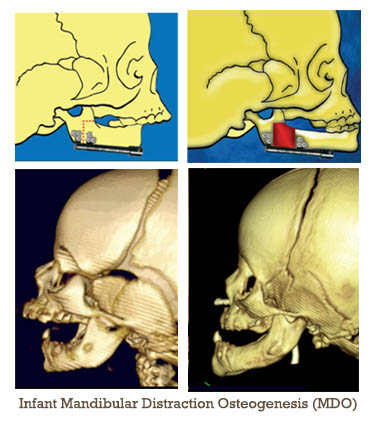Sometimes babies are born with a small lower jaw. It is called
micrognathia, which means "small mandible." It can occur in isolation, but is also a symptom of a variety of craniofacial conditions. Micrognathia may interfere with a child's feeding and breathing. For example, infants with this condition may need special nipples and positioning in order to feed properly. Outcomes for children with micrognathia are generally good, but can vary depending on the severity of the condition.
Infants
Micrognathia can appear in infants by itself or as part of a
syndrome (where more than one body system is involved). A syndrome may be
inherited (passed down from the parents) or come about spontaneously.
Pierre Robin Sequence
A small jaw is often seen as part of
Pierre Robin Sequence. Pierre Robin occurs in about one per 8,500 live births. It is called a "sequence," because while the baby is growing in the womb, the lower jaw does not grow enough. This causes the tongue to be pushed back and the palate bones to remain separated in the middle. Babies born with Pierre Robin may have difficulty with breathing, feeding, and/or sleeping. It can be a very mild problem to quite severe.
-
Babies born with mild forms of Pierre Robin will be discharged home with close follow up in the pediatrician's office. Parents are advised to keep a close watch on their baby due to partial airway blockage associated with obstructive
sleep apnea. These infants may also have trouble feeding and suffer from
gastrointestinal reflux.
-
Babies born with more severe forms Pierre Robin can't leave the hospital after birth and need extra measures to protect their breathing. A breathing tube attached to a ventilator may be needed temporarily.
Obstructive Sleep Apnea
The airway is at the most risk for blockage at night when all the muscles are relaxed. When a child's tongue is in a backward position due to a small jaw, his or her attempts to breath when sleeping can be met with partial or complete blockage. This is called
obstructive sleep
apnea. It occurs in about 2% of children.
Obstructive sleep apnea causes decreases in the blood's ability to carry oxygen to the developing organs, so it can interfere with development. In children with obstructive sleep apnea and micrognathia, surgical treatment of the airway can be an emergency.
Treatment of Micrognathia
Early diagnosis and ongoing monitoring help with a multi-disciplinary team of specialists will determine the best time to medically or surgically intervene. If your baby has micrognathia, you may meet with:
If the child can tolerate it, a sleep study is done to see how bad his or her airway is obstructed. If the results are severe, then a formal airway evaluation by the pediatric ENT is done in the operating room to assess the anatomy of the upper airway.
Mandibular Distraction Osteogenesis
 Mandibular Distraction Osteogenesis (MDO) is a surgical procedure that makes the lower jaw larger by slowly lengthening the lower jaw bone. The surgeon makes cuts on both sides of the lower jaw and attaches turning devices which expand the space in the bone cut. By turning the devices, the jaw moves forward (and with it, the tongue). The airway will then get bigger, and within a couple of weeks from the surgery, the breathing/sleeping problem will be improved.
Mandibular Distraction Osteogenesis (MDO) is a surgical procedure that makes the lower jaw larger by slowly lengthening the lower jaw bone. The surgeon makes cuts on both sides of the lower jaw and attaches turning devices which expand the space in the bone cut. By turning the devices, the jaw moves forward (and with it, the tongue). The airway will then get bigger, and within a couple of weeks from the surgery, the breathing/sleeping problem will be improved.
Risks for MDO surgery include damage to tooth buds, sensory nerve damage, facial nerve damage, relapse of the original condition, and infection. After 6 weeks, the new bone has formed and the devices are removed. Usually, the child can go home during this period of bone formation. Additional benefits of MDO are improved feeding, decreased reflux, and avoidance of a permanent breathing tube called a tracheostomy.
Childhood Concerns
Regardless of whether or not a child undergoes MDO as an infant, he or she will need to be followed for:
- Jaw growth
- Dental (tooth) development
- Lower lip sensation
- Airway health
Sometimes, a second (or even first) MDO is needed during childhood if breathing and sleep apnea problems persist. Many children born with micrognathia will eventually need
orthodontic care, as well. Some eventually require corrective jaw surgery after growth is complete in adolescence.
Additional Information: